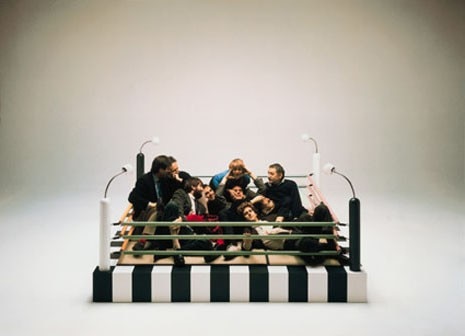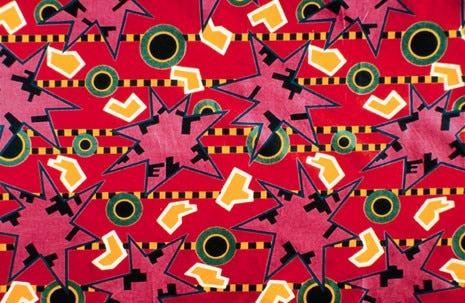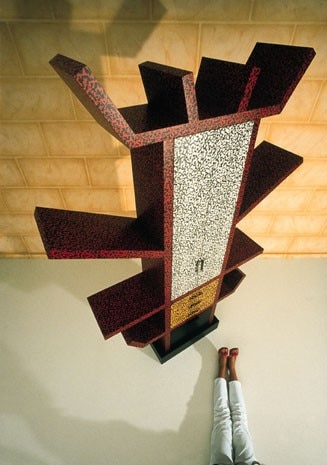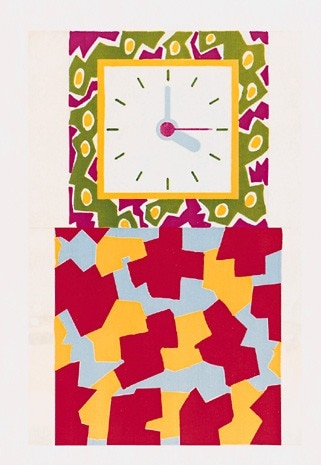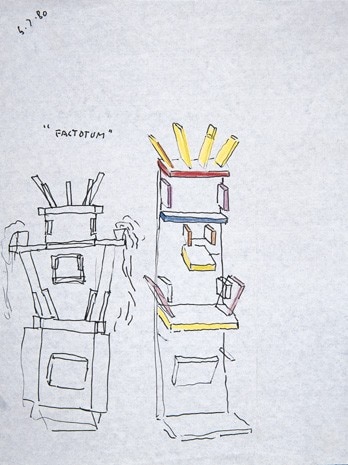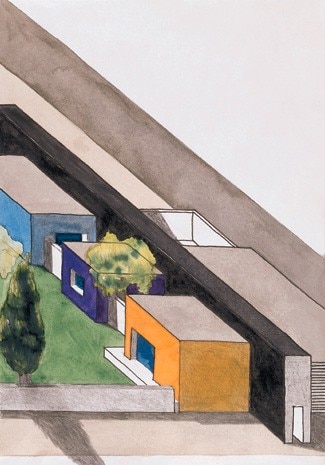Stefano Casciani reports
"What, after all this, is the purpose of Memphis?".
"The purpose of Memphis is to exist".
Barbara Radice interviews Ettore Sottsass, 1982
Those of us who were there for the unveiling of the first Memphis collection in Milan on that hot evening of 18 September 1981 – the myths say a thousand or so – are facing up to grey hair now.
The objects, and there were a good few of them, 57 to be precise, have probably lasted better. There were four tables, two coffee-tables, a trolley, a screen, two chairs, eleven lamps, three table-clocks, eleven ceramic objects, two beds, sixteen "pieces of furniture" (comprising wardrobes, bookcases, chests of drawers and glass cabinets), a writing desk, a settee, an armchair and a coat stand.
The collection was the product of the work of a score of designers, manufactured by a host of suppliers with a group of supporters that included two craft makers – Renzo Brugola and Fausto Celati, Ernesto Gismondi, Artemide’s owner as well as Mario and Brunella Godani proprietors of the Arc ‘74 show-room, the venue chosen for the Memphis event, and of course, Ettore Sottsass and some of his friends. My most vivid memories, not necessarily in sequential order, are:
- the stairs down to the basement of the Godani show-room in Corso Europa packed with a continual crowd of enthusiastic people moving up and down;
- a huge party with an unlikely mix of people; some of them vigorous partisans of Modernism, some not, who all somehow seemed to agree that they were taking part in a historic event;
- the attempts of the most dilligent guests to identify the work of the very different designers taking part, to tell Sottsass from Hollein, Mariscal, from Graves, to find what – if anything – Isozaki, Nathalie Du Pasquier, Martine Bedin, Masanori Umeda had in common. To say nothing of Alessandro Mendini (whom Sottsass had included in the first Memphis collection in an ecumenical gesture, despite his less than positive experience with Studio Alchimia in the prelude to Memphis). And to find them at all, lost in the party crowd which was, as at any party worth its salt, mainly intent on having a good time;
- the array of Abet plastic laminates, lacquers and enamels, burr wood, plastics, textiles, patterns and, above all, colour – in a joyous celebration of finishes in a riotous combination that not even the most outlandish Brianza manufacturer of high kitsch furniture would have dreamt of using altogether.
Nothing at that event was accidental or left to chance (apart, of course, from the formal and chromatic courage, let us say, of the designers).
In fact the Memphis launch was the culmination of long-drawn out period of careful preparation. Sottsass had started to gather together a group of designers as early as the December of the previous year. He was collecting the people he saw as being fresh enough; and quick enough to understand the need for changes in design, and with the toughness to withstand the fallout from the impact of what they were doing would have in the world of Italian furniture deeply entrenched in the logic of modular systems.
A friend of mine, not long in Milan at that time, was a guest of Paola Navone who made a decisive contribution to the success of Memphis while working with Abet. My friend remembers arriving home one evening and going straight to bed to keep out of the way of the group of young but already illustrious designers gathered in Navone’s living room. Although this may not have been that famous evening on which, according to the legend fuelled by Barbara Radice, the name Memphis was born when the famous Bob Dylan record, on the famous turntable of the famous record player played the famous song that goes: "Oh Mama, can this really be the end, to be stuck inside the mobile, with the Memphis blues again" over and over again, something significant was clearly happening. In the drowsiness that precedes sleep my friend realised that the discussion, as spirited as it was amicable, was developing a project that would upset the laboriously-created equilibrium of the design market. Sottsass and his friends were thinking about the creation of a New International Style (their slogan). A style that would poke fun at the defensive stockades, the barriers and enclosures that littered the landscape of design in Italy that confined the universe of objects to the geometry of good design. This sort of ‘prohibition’– according to Paolo Portoghesi’s definition – was to be replaced by a sensibility that was half Art Déco half Pop, appealing part to an élite taste, and part populist, half serious half tongue in cheek. It was based on an acceptance that the imagery of even the highest culture is sooner or later consumed by the everyday world.
At the same time Sottsass, like Mendini with his work at Alchimia, Alessi and Domus, also grasped that if high culture could become populist, then the opposite was also true. What has come down can also go up again, in design too. Hence, the Memphis objects clearly manifest the concept of retrieving the most ordinary everyday images, forms and colours – from the "almond-pattern" metal used for bus stops in the 1950s to the laminate of bar chairs (again from forty years ago), and transforming their meaning by raising them to the status of élite objects.
Even the choice of names for the pieces in the first collection – Carlton, Plaza, Splendid all referred to names shared by both grand hotels and humble guest houses around the world from Calcutta to Sydney – hint at this ambiguity.
This is all, of course, easy to talk about now, but at the time it sounded like heresy. Indeed some suggested rounding up the culprits and burning them at the stake for this threat to the modern tradition. In the environs of the very temple of the design Kultur, the Milan Furniture Fair (although not actually inside the Fair itself; where the costs benefit analysis of making such radical gestures remains uncertain), people were engaged in what amounted to pagan rites and under the aegis of an undisputed Founding Father of Italian design. But the outrage was quickly overwhelmed by the popular response. Even before the first show, press coverage was building up, and tabloids, popular magazines and Sunday supplements around the world were soon full of the great new phenomenon of Italian design. After just two years the pieces were being purchased by the museums – the Victoria & Albert in London held a Memphis exhibition as early as 1982. The work was acquired by the Israel Museum in Jerusalem, the Philadelphia Museum of Art and many others. Karl Lagerfeld had himself photographed in his Monte-Carlo flat furnished entirely with Memphis pieces. Immediately the easily imitated Memphis language began to infect the work of a generation of designers and students. And there were many collectors and dealers in the market for Memphis originals. They proved to be far sighted in their investments. As as a testimony to a valiant phase in Italian design they are highly significant in themselves. And since the Memphis experience ended in 1988 when Sottsass officially ‘released’ everyone the value of all Memphis production – or at least that which was dated as museum pieces – has been confirmed. It was not long before Sottsass could see Memphis being swallowed and stripped of meaning by the impact of the very media coverage that had driven it to global prominence.
In their breathless enthusiasm for novelty the media find it impossible to present cultural change as anything other than a series of discontinuous miracles. Design is reduced to a constant series of shortlived marvels rather than the occasional appearance of something that has slowly matured over the years. But if Memphis really was the force that defined the Eighties, the decade that turned out to be the beginning of design and architecture’s decline into fashion (as Vittorio Gregotti says it is) and the cycles are always repeated, then why wasn’t there a similar conjunction of the stars to produce another creative explosion at the beginning of the 1990s or in 2000? In fact we are approaching the end of 2001 without many new ideas having emerged in Italian design to match the impact of that first Memphis collection unveiled 20 years ago.
The talents that formed the group or rather collaborated with it, even if only once, were exceptional. They have continued to produce objects and architecture, that is usually of consistently high and sometimes extremely innovatory, quality.
The fundamental truth is that – as in the case of the "Italy the New Domestic Landscape" exhibition at the MoMA in 1972 – Memphis represented a point of no return for Italian design, a declaration of war on the past – and, equally, of surrender to the future – by a generation of designers that is today having difficulty rediscovering the anti-classical sparkle.
Certainly there could be a new idea for Italy – the launch of a new glocal ("global-local") design movement, a cross between Microsoft hyper-technology, with its sure financial return, and the age-old Italian formal mastery, with its sure return in terms of image. But the signs are not so good.
We are grateful for the kind assistance received from Alberto Albricci of Memphis, Pregnana Milanese, which under licence from the designers reproduces pieces from the original Memphis collections dating from 1981.
"Memphis Remembered", Design Museum London,
until 31.10.2001
